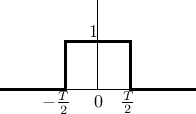Next |
Prev |
Up |
Top
|
Index |
JOS Index |
JOS Pubs |
JOS Home |
Search
The 2-sample wide triangular pulse  (Eq.(4.4)) can be
expressed as a convolution of the one-sample rectangular pulse with
itself.
(Eq.(4.4)) can be
expressed as a convolution of the one-sample rectangular pulse with
itself.
Figure 4.8:
The width  rectangular pulse.
rectangular pulse.
 |
The one-sample rectangular pulse is shown in Fig.4.8
and may be defined analytically as
where  is the Heaviside unit step function:
is the Heaviside unit step function:
Convolving  with itself produces the two-sample triangular pulse
with itself produces the two-sample triangular pulse
 :
:
While the result can be verified algebraically by substituting
 for
for  , it seen more quickly via
graphical convolution.
, it seen more quickly via
graphical convolution.
Next |
Prev |
Up |
Top
|
Index |
JOS Index |
JOS Pubs |
JOS Home |
Search
[How to cite this work] [Order a printed hardcopy] [Comment on this page via email]
![]() (Eq.(4.4)) can be
expressed as a convolution of the one-sample rectangular pulse with
itself.
(Eq.(4.4)) can be
expressed as a convolution of the one-sample rectangular pulse with
itself.

![$\displaystyle u(t) \isdef \left\{\begin{array}{ll}
1, & t\geq 0 \\ [5pt]
0, & t<0 \\
\end{array} \right..
$](img971.png)
